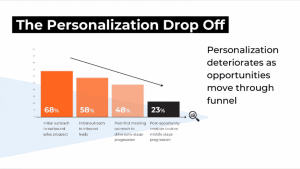These days, every business is in the data business, and columnist Sean Zinsmeister explains that to make better decisions, leaders need to use machine learning and analytics to find actionable patterns in the data.

Most marketing (and sales) teams have seemingly simple goals: identify your best customers, target prospects who look like them, facilitate a positive buying experience, and bring these prospects into your customer community.
The challenge with this is that companies are faced with an onslaught of data, making it impossible to economically throw humans at each of the aforementioned objectives. Much business learning and many routine tasks can be done faster and better with automation and AI. People simply will never be able to sift through all that data at the same rate as machines, and certainly not with the precision that well-designed algorithms can bring to the table.
These days, every business is in the data business, and in order to make better decisions, leaders need machine learning and analytics to find actionable patterns in the data. But first, it’s important to clearly define the problem you’re trying to solve. For example, if your company struggles with customer churn issues, you might want to employ algorithms to figure out how to reduce the churn. In that case, you’d need to understand when someone is likely to churn so you can make an offer to reduce the risk. Another question might be why someone churns, but that’s a completely separate problem for a different algorithm to solve.
Once you’ve narrowed down your scope to an initial marketing problem, machine learning algorithms will undoubtedly be well-suited to tackle it with the historical prospect and customer data from your CRM, marketing automation or data warehouses. As you get started, it’s helpful to be able to speak the same language as your data practitioners and/or predictive analytics vendor. Let’s take a peek behind the curtain to gain a basic understanding of the key algorithmic approaches used in marketing.

Classification
Also known as “class probability estimation,” classification modeling is an excellent approach for defining your best customers. These algorithms basically answer the question of whether something fits in one group or another. For example, “Is this segment likely or not likely to respond to our marketing offer?” Autopilot, a leading marketing automation provider, uses predictive analytics with classification models to measure its marketing channel performance and determine where marketing dollars should be invested or rerouted.
To train a classification model, you’ll divide your historical prospect and customer data into two groups, e.g., responded and didn’t respond, ideal and non-ideal prospect or customers and non-customers. This classifier allows the algorithm to tune to both the positive attributes of your best customers and the negative attributes of your non-ideal customers. The finalized model can then be used to “score” your existing database, as well as all new prospects in the future, for their likelihood of converting or becoming a customer.

Regression
Another technique that can take your marketing to the next level is using regression modeling to predict a specific value for information that’s important to you. This approach is related to classification, which predicts whether something will happen, but it’s different because regression (otherwise known as value estimation) predicts how much something will happen. The algorithms might look at similar individuals in a population and their historical usage in order to produce a numerical prediction for, say, “How much of Product X will be used by Segment A?”
A great use case for regression modeling is to look at how much more revenue you might be able to extract from a particular account through cross-sell or upsell opportunities. BrightCove, a leading online video platform, uses predictive analytics in this way to help increase contract values from its existing customer base. (Disclosure: BrightCove is a customer of my employer, Infer.)
In addition, companies with tiered pricing could use a similar algorithm to generate the estimated value of each new prospect (either for the initial sale or the full lifetime customer value). With this insight, they might handle leads differently — perhaps by routing lower-value prospects to a self-service option in order to maintain efficiency so they can give a white-glove treatment to the most valuable prospects.

Clustering
Finally, clustering models group individuals in a population based on their similarity. A marketing question for this type of algorithm might be, “Do our customers form natural segments?” This information can be especially useful for preliminary domain exploration or determining how your customer support or sales team should be structured. By analyzing your database of prospects and customers, these models assign everyone into “clusters” defined by their similar attributes.
Clustering’s open-ended approach still relies on the data versus human intuition in order to identify the most predominant traits in the people you’re marketing to. As a result, you’ll gain fresh insight into your customer universe (or total addressable market) and find new segments of customers and prospects. Marketers can then use key cohort signals to develop targeted campaigns or more personalized sales strategies, and to identify others who look similar to top-performing clusters.

The specific examples above demonstrate how dramatically AI is changing the way companies understand and process their data. What’s great is that you don’t need a degree in data science to understand the benefits of these algorithms, or to leverage their outputs. In summary, there are three primary ways algorithms can help sales and marketing teams:
- Find “white space” in the pipeline. By identifying opportunities to measurably optimize conversions, algorithms can rapidly make an impact on revenue growth.
- Perform true automation to reduce human labor. Every business carries at least some inefficiencies (such as manual lead research) that can easily be replaced by highly efficient algorithms and predictive analytics.
- Enrich traditional applications. Algorithms can also help teams get more out of their sales and marketing stack by adding a layer of intelligence that finds important patterns in the data to drive agility and a competitive edge.
Some of the best opportunities for go-to-market teams center around uncovering inefficiencies in the business — e.g., reducing marketing waste, accelerating lead or account qualification, optimizing channels and programs. Since the potential returns of improved sales and marketing performance are significant, there’s no reason to wait. It’s time for every marketer to recognize that an arms race for data is underway, and those who don’t evolve the way their businesses operate based on data will soon fall behind.
Some opinions expressed in this article may be those of a guest author and not necessarily Marketing Land. Staff authors are listed here.
Marketing Land – Internet Marketing News, Strategies & Tips
(98)
Report Post








